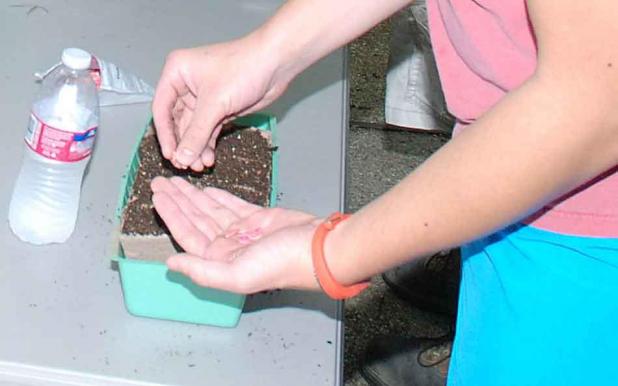
Seeds may be planted thickly into plastic flats, trays, pots or other handy containers for later transplanting. Containers should be clean and sturdy, have drainage holes and fit into the space available for growing the young plants.
—LSU AgCenter/Johnny Morgan Photo
Get it Growing: Start plants from seeds
At some point, many gardeners discover seed catalogs offer a much greater selection of annual flowers and vegetables than can be found at the local nursery. To grow those wonderful plants, however, you must be able to grow your own transplants from seed.
Here’s how to do it.
CONTAINERS FOR SOWING SEEDS
Containers should be clean and sturdy, have drainage holes and fit into the space available for growing the young plants.
Seeds may be planted thickly into plastic flats, trays, pots or other handy containers for later transplanting into smaller individual containers. Starting seeds this way initially saves space but involves additional labor transplanting the young seedlings into individual pots when they are large enough.
If you prefer, you can plant seeds directly into individual pots. Choices include small clay or plastic pots, plastic cell packs, peat pots, or foam or paper cups with holes for drainage.
GROWING MEDIA
The medium used for starting seeds should be sterile, easily drained and finely textured. Excellent commercially prepared mixes are available for growing seeds. Light, easily drained potting soils will also generally be satisfactory, especially with larger seeds. Do not use garden soil.
PLANTING SEEDS
Fill the container almost to the top with moistened medium, level it and gently firm it with your hand. Scatter or broadcast the seeds evenly over the surface. If you’re using individual pots, plant two or three seeds per pot — all but one seedling will be pinched off if they all germinate — or sow a number of seeds fairly thickly in a larger container for transplanting into individual pots later.
Lightly cover the seeds to the depth recommended on the seed package. Very fine seeds need not be covered. Label each pot promptly with the plant type, variety name and planting date.
Water in the seeds with a fine spray, being careful not to flood the container. Continue watering as needed to keep the medium evenly moist but not soggy until you’re ready to transplant the seedlings. Never let it dry out.
Place the container in a warm location, although light is not critical at this point unless the seeds need light to germinate. Generally, a temperature range from 65 to 75 degrees is best. Gentle bottom heat can speed germination and can be provided by special heating cables available at nurseries or by mail order. If the weather is warm, the containers may be placed in a shady spot outside.
Watch daily for germination. The seed package should indicate the number of days required. Move the germinated seedlings to bright light as soon as the first leaves appear. This is very important. Water regularly because seedlings quickly die if allowed to dry out.
GROWING THE SEEDLINGS
Light is especially critical once the seeds germinate. If the seedlings begin to stretch and look leggy, they are not getting enough light.
Grow the seedlings in a sheltered location outside in spring, summer and fall when conditions are warm enough. Seedlings of sun-loving plants should receive about six hours of sun. Seedlings of plants that prefer shadier conditions should receive two or three hours of morning sun.
It is common to start seeds indoors this time of year when it’s chilly outside. Place the containers of seedlings in the sunniest window you have. If you don’t have a sunny window, you can successfully grow seedlings using a utility fluorescent light fixture suspended on chains from hooks. Position the fixture 3 inches above the seedlings and leave it on 14 to 16 hours a day. Raise the fixture on chains as the seedlings grow.
Whether inside or outside, regularly water and fertilize seedlings once a week with 20-20-20 soluble fertilizer mixed half strength.
As soon as the seedlings are large enough to handle, they should be carefully separated and transplanted into individual pots or, if already growing in individual pots, thinned to one plant per pot. When transplanting, always handle the small seedlings by a leaf because their thin stems break easily.
Planting into the garden
When plants are large enough — they need not be in bloom — plant them into the garden when weather conditions are suitable. Plants grown indoors or in greenhouses need to be acclimated to the outside environment before planting. Place them in a protected, shady location and allow them to wilt slightly between waterings. Over the next 10 days, gradually expose them to more light.
Plant transplants into well-prepared beds at the same depth they were growing in the container and space them according to seed package recommendations.
Congratulations! You have just entered a new and wonderful phase of gardening.
